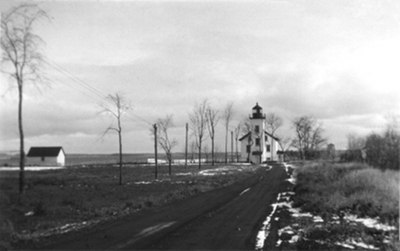Lightning Strikes the Lighthouse
Sand Point Light
Escanaba, Michigan
1906
This is best read as an extension or amplification toLighthouse keeper's family
Born in a Lighthouse: Sand Point, Michigan, 1888
by Edith Rose Franson. Please read that memoir first!
 My grandfather, Lewis A. Rose, was appointed keeper of the Escanaba lighthouse on Sand Point in 1886. My mother, Edith Rose, was born in the lighthouse in 1888. The operation of a lighthouse in the early days was often a family affair. The old lights were oil burners and somebody had to keep track of the oil supply, trim the wicks, and clean the lenses. There always was something that needed cleaning, adjustment, or repairs.
My grandfather, Lewis A. Rose, was appointed keeper of the Escanaba lighthouse on Sand Point in 1886. My mother, Edith Rose, was born in the lighthouse in 1888. The operation of a lighthouse in the early days was often a family affair. The old lights were oil burners and somebody had to keep track of the oil supply, trim the wicks, and clean the lenses. There always was something that needed cleaning, adjustment, or repairs.
My grandmother, Mary Potter Rose, carried her share of the work load and on one occasion she rang the fog bell for a whole day and a night with only brief periods of rest. I don't know whether the bell was normally run by hand or had some kind of mechanism that failed that day. Lives may have depended on that bell, which could not be allowed to fail. No radio, no modern aids to navigation, just the seamen's knowledge of the dangerous areas and their faith that the lights and bells would always be there. The old fog bell was later replaced by a fog horn.
One day in the Summer of 1906, when my mother Edith Rose was eighteen years old, she was up in the forty-foot tower, polishing the big lens, when lightning struck the tower. She found herself outside on the ground, with no idea of how she had come down the winding iron stairway in the tower. Her younger brother [Clarence A. Rose, age 14] was in the building, and he was temporarily deafened by the blast. A pump organ, treasured by the family, exploded and scattered pieces around the room. Some of the lead in the windows melted, and some glass shattered. Fortunately the house was (and is) very solid: four rows of bricks in the walls.
She said the lightning bolt came out of a clear sky, but she may have been so busy in the tower she did not notice the clouds. (The lighthouse tower stuck up like a big lightning rod, on the little peninsula into Lake Michigan, so was a natural target for lightning. I do not know whether the tower had lightning rods on it.)
Sometimes Indians would camp on the Point (vacant bare land), and when their bonfires got too big and things got a little rowdy, my grandfather would walk down there, and using all of the authority vested in him by the great, distant government, would persuade the Indians to cool it.
Lewis A. Rose left the lighthouse service in 1913, worked as head of the land department for the I. Stephenson Company. He was killed (as described by the Escanaba Daily Press) "when two street cars of the Escanaba Traction Company's line met in a headon collision near the Wells station shortly before 8:30 o'clock yesterday morning", 9 May 1924. He was riding on the front platform of the streetcar; nine others were hurt in the interurban car crash. When he died he was a member of the Escanaba City Council; there were 150 automobiles in his funeral procession.
My cousin Ralph E. Rose's researches have shown that over the years, members of the Rose family manned five different lighthouses on Lake Michigan. Now all the lighthouses are automated, but the lonely, responsible work of the lighthouse keepers and their families has not been forgotten.
As a child my mother was very proud of her home, the lighthouse. In one of her school books, a collection of Hawthorne's stories, she wrote proudly at the age of ten,
Edith Rose
Light House
She knew that address, which needed no street name or house number, was a mark of distinction granted to only a few families.
© 1979, 2005 Wilfred R. Franson
Sand Point Lighthouse photo by
Donald L. Franson, 11 November 1934
An earlier version was published in
The Delta Historian January 1979,
Delta County Historical Society
More on lighthouses and their operation:
Terry Pepper's
Seeing the Light: Lighthouses of the Western Great Lakes
More by Wilfred R. Franson
| Troynovant, or Renewing Troy: | New | Contents | |||
| recurrent inspiration | Recent Updates | |||
|
www.Troynovant.com |
||||
|
Essays:
A-B
C-F
G-L
M-R
S-Z
|
||||
| Personae | Strata | Topography | |
|
|||